Atlantic cod
The Atlantic cod (Gadus morhua) is a benthopelagic fish of the family Gadidae, widely consumed by humans. It is also commercially known as cod or codling.[2][n 1] Dry cod may be prepared as unsalted stockfish,[3][9][n 2] as cured salt cod or clipfish.[n 3]
| Atlantic cod | |
|---|---|
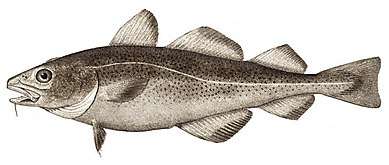 | |
| Scientific classification | |
| Kingdom: | Animalia |
| Phylum: | Chordata |
| Class: | Actinopterygii |
| Order: | Gadiformes |
| Family: | Gadidae |
| Genus: | Gadus |
| Species: | G. morhua |
| Binomial name | |
| Gadus morhua | |
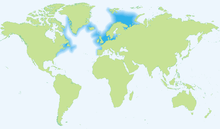 | |
| Distribution of Atlantic cod | |
| Synonyms | |
| |
In the western Atlantic Ocean, cod has a distribution north of Cape Hatteras, North Carolina, and around both coasts of Greenland and the Labrador Sea; in the eastern Atlantic, it is found from the Bay of Biscay north to the Arctic Ocean, including the Baltic Sea, the North Sea, Sea of the Hebrides,[13] areas around Iceland and the Barents Sea.
The largest individual on record was 1.5 m (5 ft) long and weighed 47 kg (103 lb), but usually the cod is between 61 cm (24 in) and 1.2 m (4 ft) long and weighs up to 40 kg (88 lb). Males and females are similar in size and weight.[14][15]
Atlantic cod can live for 25 years, and usually attain sexual maturity between ages two and four,[16] although cod in the northeast Arctic can take as long as eight years to mature fully.[17] Colouring is brown or green, with spots on the dorsal side, shading to silver ventrally. A stripe along its lateral line (used to detect vibrations)[18] is clearly visible. Its habitat ranges from the coastal shoreline down to 305 m (1000 ft) along the continental shelf. Atlantic cod is one of the most heavily fished species. Atlantic cod was fished for thousand years by north European fishers who followed it across the North Atlantic Ocean to the North Americas. It was supporting the US and Canada fishing economy until 1992 when there was a ban on fishing cod. Several cod stocks collapsed in the 1990s (declined by >95% of maximum historical biomass) and have failed to fully recover even with the cessation of fishing.[19] This absence of the apex predator has led to a trophic cascade in many areas.[19] Many other cod stocks remain at risk. The Atlantic cod is labelled vulnerable on the IUCN Red List of Threatened Species.[1]
Lifecycle
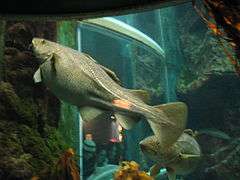 Gravid female in captivity
Gravid female in captivity.jpg) Atlantic cod juvenile
Atlantic cod juvenile- Adult
Adult cod form spawning aggregations from late winter to spring.[20][21] Females release their eggs in batches,[22] and males compete to fertilize them.[23][24][25] Fertilized eggs drift with ocean currents and develop into larvae ("fry"). Age of maturation varies between cod stocks, from ages two to four in the west Atlantic,[26] but as late as eight years in the northeast Arctic.[17] Cod can live for 13 years or more.[27]
Taxonomy
The Atlantic cod is one of three cod species in the genus Gadus along with Pacific cod and Greenland cod. A variety of fish species are colloquially known as cod, but they are not all classified within the Gadus, though some are in the Atlantic cod family, Gadidae.
Behaviour
Shoaling
Atlantic cod are a shoaling species and move in large, size-structured aggregations. Larger fish act as scouts and lead the shoal's direction, particularly during post spawning migrations inshore for feeding. Cod actively feed during migration and changes in shoal structure occur when food is encountered. Shoals are generally thought to be relatively leaderless, with all fish having equal status and an equal distribution of resources and benefits.[28] However, some studies suggest that leading fish gain certain feeding benefits. One study of a migrating Atlantic cod shoal showed significant variability in feeding habits based on size and position in the shoal. Larger scouts consumed a more variable, higher quantity of food, while trailing fish had less variable diets and consumed less food. Fish distribution throughout the shoal seems to be dictated by fish size, and ultimately, the smaller lagging fish likely benefit from shoaling because they are more successful in feeding in the shoal than they would be if migrating individually, due to social facilitation.[29]
Predation
Atlantic cod are apex predators in the Baltic and adults are generally free from the concerns of predation.[30] Juvenile cod, however, may serve as prey for adult cod, which sometimes practice cannibalism. Juvenile cod make substrate decisions based on risk of predation. Substrates refer to different feeding and swimming environments. Without apparent risk of predation, juvenile cod demonstrated a preference for finer-grained substrates such as sand and gravel-pebble. However, in the presence of a predator, they preferred to seek safety in the space available between stones of a cobble substrate. Selection of cobble significantly reduces the risk of predation. Without access to cobble, the juvenile cod simply tries to escape a predator by fleeing.
Additionally, juvenile Atlantic cod vary their behaviour according to the foraging behaviour of predators. In the vicinity of a passive predator, cod behaviour changes very little. The juveniles prefer finer-grained substrates and otherwise avoid the safer kelp, steering clear of the predator. In contrast, in the presence of an actively foraging predator, juveniles are highly avoidant and hide in cobble or in kelp if cobble is unavailable.[31]
Heavy fishing of cod in the 1990s and the collapse of American and Canadian cod stocks resulted in trophic cascades. As cod are apex predators, overfishing them removed a significant predatory pressure on other Atlantic fish and crustacean species. Population-limiting effects on several species including American lobsters, crabs, and shrimp from cod predation have decreased significantly, and the abundance of these species and their increasing range serve as evidence of the Atlantic cod's role as a major predator rather than prey.[30]
Swimming
Atlantic cod have been recorded to swim at speeds of a minimum of 2–5 cm/s (0.79–1.97 in/s) and a maximum of 21–54 cm/s (8.3–21.3 in/s) with a mean swimming speed of 9–17 cm/s (3.5–6.7 in/s). In one hour, cod have been recorded to cover a mean range of 99 to 226 m2 (1,070 to 2,430 sq ft). Swimming speed was higher during the day than at night. This is reflected in the fact that cod more actively search for food during the day. Cod likely modify their activity pattern according to the length of daylight, thus activity varies with time of year.[32]
Response to changing temperatures
Swimming and physiological behaviours change in response to fluctuations in water temperature. Respirometry experiments show that heart rates of Atlantic cod change drastically with changes in temperature of only a few degrees. A rise in water temperature causes marked increases in cod swimming activity. Cod typically avoid new temperature conditions, and the temperatures can dictate where they are distributed in water. They prefer to be deeper, in colder water layers during the day, and in shallower, warmer water layers at night. These fine-tuned behavioural changes to water temperature are driven by an effort to maintain homeostasis to preserve energy. This is demonstrated by the fact that a decrease of only 2.5 °C (5 °F) caused a highly costly increase in metabolic rate of 15 to 30%.[33]
Feeding and diet
The diet of the Atlantic cod consists of fish such as herring, capelin, and sand eels, as well as mollusks, crustaceans and sea worms. Stomach sampling studies have discovered that small Atlantic cod feed primarily on crustaceans, while large Atlantic cod feed primarily on fish.[34] In certain regions, the main food source is decapods with fish as a complementary food item in the diet.[35] Wild Atlantic cod throughout the North Sea depend, to a large extent, on commercial fish species also used in fisheries, such as Atlantic mackerel, haddock, whiting, Atlantic herring, European plaice, and common sole, making fishery manipulation of cod significantly easier.[34] Ultimately, food selection by cod is affected by the food item size relative to their own size. However, providing for size, cod do exhibit food preference and are not simply driven by availability.[34]
Atlantic cod practice some cannibalism. In the southern North Sea, 1–2% (by weight) of stomach contents for cod larger than 10 cm (3.9 in) consisted of juvenile cod. In the northern North Sea, cannibalism was higher, at 10%.[34] Other reports of cannibalism have estimated as high as 56% of the diet consists of juvenile cod.[36]
Reproduction
.png)
Atlantic cod reproduce during a 1- to 2-month spawning season annually. Males and females aggregate in spawning schools and each spawning season yields an average of 8.3 egg batches. Spawning occurs in February or April and a female can have as many as 9 million eggs. The eggs and newly hatched young float freely in the water.[37] Females release gametes in a ventral mount, and males then fertilize the released eggs. Evidence suggests male sound production and other sexually selected characteristics allow female cod to actively choose a spawning partner. Males also exhibit aggressive interactions for access to females.[38] Based on behavioral observations of cod, that cod mating systems resemble those of lekking species, which is characterized by males aggregating and establishing dominance hierarchies, at which point females may visit and choose a spawning partner based on status and sexual characteristics.[36]
Cod males experience reproductive hierarchies based on size. Larger cod males are ultimately more successful in mating and produce the largest proportion of offspring in a population. However, cod males do experience high levels of sperm competition. In 75% of examined spawning in one study, sperm from multiple males contributed to offspring. As a result of high competition and unpredictable paternity, males may engage in varied mating strategies and may invest in courtship or may simply ejaculate with other spawning couples. Spawning success also varies according to male size relative to female size. Males that are significantly smaller than females demonstrate significantly lower success rates relative to males that are larger than females.[39]
Parasites
Atlantic cod act as intermediate, paratenic, or definitive hosts to a large number of parasite species: 107 taxa listed by Hemmingsen and MacKenzie (2001)[40] and seven new records by Perdiguero-Alonso et al. (2008).[40] The predominant groups of cod parasites in the northeast Atlantic were trematodes (19 species) and nematodes (13 species), including larval anisakids, which comprised 58.2% of the total number of individuals.[40] Parasites of Atlantic cod include copepods, digeneans, monogeneans, acanthocephalans, cestodes, nematodes, myxozoans, and protozoans.[40]
Fisheries
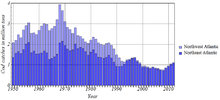
Cod populations or stocks can differ significantly both in appearance and biology. For instance, the cod stocks of the Baltic Sea are adapted to low-salinity water. Organisations such as the Northwest Atlantic Fishery Organization (NAFO) and ICES divide the cod into management units or stocks; however, these units are not always biologically distinguishable stocks. Some major stocks/management units on the Canadian/US shelf are the Southern Labrador-Eastern Newfoundland stock (NAFO divisions 2J3KL), the Northern Gulf of St. Lawrence stock (NAFO divisions 3Pn4RS), the Northern Scotian Shelf stock (NAFO divisions 4VsW), which all lie in Canadian waters, and the Georges Bank and Gulf of Maine stocks in United States waters. In the European Atlantic, the numerous separate stocks are on the shelves of Iceland, the coast of Norway, the Barents Sea, the Faroe Islands, off western Scotland, the North Sea, the Irish Sea, the Celtic Sea, and the Baltic Sea.
Northwest Atlantic cod
The Northwest Atlantic cod has been regarded as heavily overfished throughout its range, resulting in a crash in the fishery in the United States and Canada during the early 1990s.
Newfoundland's northern cod fishery can be traced back to the 16th century. On average, about 300,000 t (300,000 long tons; 330,000 short tons) of cod were landed annually until the 1960s, when advances in technology enabled factory trawlers to take larger catches. By 1968, landings for the fish peaked at 800,000 t (790,000 long tons; 880,000 short tons) before a gradual decline set in. With the reopening of the limited cod fisheries in 2006, nearly 2,700 t (2,700 long tons; 3,000 short tons) of cod were hauled in. In 2007, offshore cod stocks were estimated at 1% of what they were in 1977.[41]
Technologies that contributed to the collapse of Atlantic cod include engine-powered vessels and frozen food compartments aboard ships. Engine-powered vessels had larger nets, greater range, and better navigation. The capacity to catch fish became limitless. In addition, sonar technology gave an edge to detecting and catching fish. Sonar was originally developed during World War II to locate enemy submarines, but was later applied to locating schools of fish. These new technologies, as well as bottom trawlers that destroyed entire ecosystems, contributed to the collapse of Atlantic cod. They were vastly different from old techniques used, such as hand lines and long lines.[42]
The fishery has only recently begun to recover, and may never fully recover because of a possibly stable change in the food chain. Atlantic cod was a top-tier predator, along with haddock, flounder and hake, feeding upon smaller prey, such as herring, capelin, shrimp, and snow crab.[19] With the large predatory fish removed, their prey have had population explosions and have become the top predators, affecting the survival rates of cod eggs and fry.
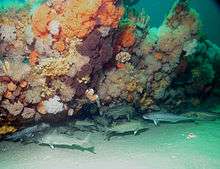
In the winter of 2011–2012, the cod fishery succeeded in convincing NOAA to postpone for one year the planned 82% reduction in catch limits. Instead, the limit was reduced by 22%. The fishery brought in $15.8 million in 2010, coming second behind Georges Bank haddock among the region's 20 regulated bottom-dwelling groundfish. Data released in 2011 indicated that even closing the fishery would not allow populations to rebound by 2014 to levels required under federal law. Restrictions on cod effectively limit fishing on other groundfish species with which the cod swim, such as flounder and haddock.[44]
Northeast Atlantic cod

The Northeast Atlantic has the world's largest population of cod. By far, the largest part of this population is the Northeast Arctic cod, as it is labelled by the ICES, or the Arcto-Norwegian cod stock, also referred to as skrei, a Norwegian name meaning something like "the wanderer", distinguishing it from coastal cod. The Northeast Arctic cod is found in the Barents Sea area. This stock spawns in March and April along the Norwegian coast, about 40% around the Lofoten archipelago. Newly hatched larvae drift northwards with the coastal current while feeding on larval copepods. By summer, the young cod reach the Barents Sea, where they stay for the rest of their lives, until their spawning migration. As the cod grow, they feed on krill and other small crustaceans and fish. Adult cod primarily feed on fish such as capelin and herring. The northeast Arctic cod also show cannibalistic behaviour. Estimated stock size was 2,260,000 t (2,220,000 long tons; 2,490,000 short tons) in 2008.
The North Sea cod stock is primarily fished by European Union member states and Norway. In 1999, the catch was divided among Denmark (31%), Scotland (25%), the rest of the United Kingdom (12%), the Netherlands (10%), Belgium, Germany and Norway (17%). In the 1970s, the annual catch rose to between 200,000 and 300,000 t (200,000 and 300,000 long tons; 220,000 and 330,000 short tons). Due to concerns about overfishing, catch quotas were repeatedly reduced in the 1980s and 1990s. In 2003, ICES stated a high risk existed of stock collapse if then current exploitation levels continued, and recommended a moratorium on catching Atlantic cod in the North Sea during 2004. However, agriculture and fisheries ministers from the Council of the European Union endorsed the EU/Norway Agreement and set the total allowable catch at 27,300 t (26,900 long tons; 30,100 short tons).[46] Seafood sustainability guides, such as the Monterey Bay Aquarium's Seafood Watch, often recommend environmentally conscious customers not purchase Atlantic cod.
The stock of Northeast Arctic cod was more than four million tons following World War II, but declined to a historic minimum of 740,000 t (730,000 long tons; 820,000 short tons) in 1983. The catch reached a historic maximum of 1,343,000 t (1,322,000 long tons; 1,480,000 short tons) in 1956, and bottomed out at 212,000 t (209,000 long tons; 234,000 short tons) in 1990. Since 2000, the spawning stock has increased quite quickly, helped by low fishing pressure. The total catch in 2012 was 754,131 t (742,221 long tons; 831,287 short tons), the major fishers being Norway and Russia.[47]
Baltic cod
There are at least two populations of cod in the Baltic Sea: One large population that spawns east of Bornholm and one population spawning west of Bornholm. Eastern Baltic cod is genetically distinct and adapted to the brackish environment. Adaptations include differences in hemoglobin type, osmoregulatory capacity, egg buoyancy, sperm swimming characteristics and spawning season. The adaptive responses to the environmental conditions in the Baltic Sea may contribute to an effective reproductive barrier, and thus, eastern Baltic cod can be viewed as an example of ongoing speciation.[48]
The western Baltic cod consists of one or several small subpopulations that are genetically more similar to the North Sea cod. In the Arkona basin (located off Cape Arkona, Rügen), spawning and migrating cod from both the eastern and western stocks intermingle in proportions that vary seasonally.[49] The immigration of eastern cod into the western Baltic management unit may mask a poor state of the populations in the western management unit.
Recommendations for management
Scientifically based recommendations for long-term conservation of Baltic cod from the research project BONUS BAMBI:
- Manage the eastern and western Baltic cod as separate units, since the eastern population is adapted to spawning in low salinity and may not be replaced by cod from elsewhere if depleted. Moreover, the large-scale fishing of Baltic cod is expected to cause (unwanted) evolutionary changes, such as reduced age and size at maturity.[50]
- Monitor mixing proportions of eastern and western cod in the Arkona basin.
- Potentially divide the western Baltic cod into more than one management unit, since it is unclear whether there are several spawning populations within this area.
Human consumption
_-_Ystad-2017.jpg)
See also
- Cod War
- Sacred Cod
Notes
- During the Middle Ages, Middle English used many, many forms of mulvel, milvel, melvel, and milwell to refer to fresh, large cod[3] and morhwell to refer to smaller ones.[4] Fresh cod was also known as the common cod,[5][6] the Scotch cod,[7] and as the green fish or greenfish.[8] "Greenfish", however, now more often refers to other fish. Similarly, "codling" may refer to various morids.
- In South Africa, however, "stockfish" refers to the local hake (Merluccius capensis).
- Former names for salted cod include cured cod,[10] ling,[10][11][12] and haberdine.[2][12] Freshly-salted cod was known as green cod, white cod, corefish,[10] coursfish,[9] and green fish or greenfish.[8] "Green cod" may also refer to the saithe (Pollachius virens), pollack (P. pollachius), or uncommonly to the lingcod (O. elongatus).[8] "Ling" now more often refers to other fish, particularly the common ling (Molva molva).[11]
References
This article incorporates CC BY-2.0 text from the reference.[40]
- J. Sobel (1996). "Gadus morhua". IUCN Red List of Threatened Species. 1996: e.T8784A12931575. doi:10.2305/IUCN.UK.1996.RLTS.T8784A12931575.en.
- Atlantic Cod Archived 2009-12-25 at the Wayback Machine. Seafood Portal.
- Oxford English Dictionary, 3rd ed. "milwell, n." Oxford University Press (Oxford), 2002.
- Oxford English Dictionary, 3rd ed. "morhwell, n." Oxford University Press (Oxford), 2002.
- Richardson, John (1836), "93. Gadus Morrhua. (Auct.) Common Cod-fish", Fauna Boreali-Americana; or the Zoology of the Northern Parts of British America: Containing Descriptions of the Objects of Natural History Collected on the Late Northern Land Expeditions under Command of Captain Sir John Franklin, R.N., Vol. III: The Fish, London: Richard Bentley, pp. 242–245.
- Grant, Francis William (1836), "Parish of Banff (Presbytery of Fordyce, Synod of Aberdeen.)", The New Statistical Account of Scotland, Vol. XI, Edinburgh: William Blackwood & Sons, p. 12.
- Riley, Henry Thomas, ed. (1860), "Glossary of Mediæval Latin", Munimenta Gildallæ Londoniensis: Liber Albus, Liber Custumarum, et Liber Horn, Vol. II, Part II., containing Liber Custumarum, with extracts from the Cottonian MS Claudius, D. II., London: Eyre & Spottiswoode for Her Majesty's Stationery Office, p. 816.
- Oxford English Dictionary, 3rd ed. "green fish, n." Oxford University Press (Oxford), 2011.
- Oxford English Dictionary, 1st ed. "stock-fish | 'stockfish, n." Oxford University Press (Oxford), 1917.
- Oxford English Dictionary, 3rd ed. "green cod, n.¹" Oxford University Press (Oxford), 2011.
- Oxford English Dictionary, 1st ed. "ling, n.¹" Oxford University Press (Oxford), 1903.
- Oxford English Dictionary, 1st ed. "† haberdine, n." Oxford University Press (Oxford), 1898.
- C.Michael Hogan, (2011) Sea of the Hebrides Archived May 24, 2013, at the Wayback Machine. Eds. P. Saundry & C.J.Cleveland. Encyclopedia of Earth. National Council for Science and the Environment. Washington DC.
- Field Guide to Fishes, National Audubon Society (2nd Edition fully revised, April 2002 ed.). Alfred A. Knopf. 2002. pp. 224. ISBN 978-0-375-41224-0.
- "Gadus morhua (Cod)". Animal Diversity Web. Retrieved 2017-02-13.
- O'Brien, L., J. Burnett, and R. K. Mayo. (1993) Maturation of Nineteen Species of Finfish off the Northeast Coast of the United States, 1985–1990. NOAA Tech. Report. NMFS 113, 66 p.
- ICES (2007), Arctic Fisheries Working Group Report, Section 03, Table 3.5, International Council for the Exploration of the Sea (accessed 2008/12/11)
- Bleckmann, Horst; Zelick, Randy (2009-03-01). "Lateral line system of fish". Integrative Zoology. 4 (1): 13–25. doi:10.1111/j.1749-4877.2008.00131.x. ISSN 1749-4877. PMID 21392273.
- Kenneth T. Frank; Brian Petrie; Jae S. Choi; William C. Leggett (2005). "Trophic Cascades in a Formerly Cod-Dominated Ecosystem". Science. 308 (5728): 1621–1623. doi:10.1126/science.1113075. PMID 15947186. S2CID 45088691.
- K. M. Brander (1994). "The location and timing of cod spawning around the British Isles". ICES Journal of Marine Science. 51 (1): 71–89. doi:10.1006/jmsc.1994.1007.
- Kai Wieland; Astrid Jarre-Teichmann & Katarzyna Horbowa (2000). "Changes in the timing of spawning of Baltic cod: possible causes and implications for recruitment". ICES Journal of Marine Science. 57 (2): 452–464. doi:10.1006/jmsc.1999.0522.
- Scott, Beth E.; Marteinsdottir, Gudrun; Begg, Gavin A.; Wright, Peter J.; Kjesbu, Olav Sigurd (2005). "Effects of population size/age structure, condition and temporal dynamics of spawning on reproductive output in Atlantic cod (Gadus morhua)". Ecological Modelling. 191 (3–4): 383–415. doi:10.1016/j.ecolmodel.2005.05.015.
- J. A. Hutchings; T. D. Bishop; C. R. McGregor-Shaw (1999). "Spawning behaviour of Atlantic cod, Gadus morhua: evidence of mate competition and mate choice in a broadcast spawner". Canadian Journal of Fisheries and Aquatic Sciences. 56 (1): 97–104. doi:10.1139/cjfas-56-1-97. Archived from the original on 2012-07-07.
- J. T. Nordeide; Folstad (2000). "Is cod lekking or a promiscuous group spawner?". Fish and Fisheries. 1 (1): 90–93. doi:10.1046/j.1467-2979.2000.00005.x.
- D. Bekkevold; M. M. Hansen & V. Loeschcke (2002). "Male reproductive competition in spawning aggregations of cod". Molecular Ecology. 11 (1): 91–102. doi:10.1046/j.0962-1083.2001.01424.x. PMID 11903907. S2CID 12017909.
- O'Brien, L., J. Burnett, and R. K. Mayo. (1993) Maturation of Nineteen Species of Finfish off the Northeast Coast of the United States, 1985–1990. NOAA Tech. Report. NMFS 113, 66 p.
- ICES (2007), Arctic Fisheries Working Group Report, Section 03, International Council for the Exploration of the Sea Archived 2011-06-12 at the Wayback Machine (accessed 2008/12/11)
- Pitcher, TJ, Parrish JK (1993). Functions of shoaling behaviour in teleosts. Chapman and Hall. pp. 363–427.
- DeBlois, Elisabeth M.; Rose, George A. (1 January 1996). "Cross-shoal variability in the feeding habits of migrating Atlantic cod (Gadus morhua)". Oecologia. 108 (1): 192–196. doi:10.1007/BF00333231. PMID 28307750.
- Steneck, R. S. (14 May 2012). "Apex predators and trophic cascades in large marine ecosystems: Learning from serendipity". Proceedings of the National Academy of Sciences. 109 (21): 7953–7954. doi:10.1073/pnas.1205591109. PMC 3361373. PMID 22586126.
- Gotceitas, V; S. Fraser; J.A. Brown (1995). "Habitat use by juvenile Atlantic cod (Gadus morhua) in the presence of an actively foraging and non-foraging predator". Marine Biology. 123 (3): 421–430. doi:10.1007/bf00349220.
- LØKKEBORG, SVEIN (1 August 1998). "Feeding behaviour of cod, Gadus morhua: activity rhythm and chemically mediated food search". Animal Behaviour. 56 (2): 371–378. doi:10.1006/anbe.1998.0772. PMID 9787028. S2CID 25607249.
- Claireaux, G; et al. (1995). "Physiology and behaviour of free-swimming Atlantic cod (Gadus morhua) facing fluctuating temperature conditions". Journal of Experimental Biology. 198 (1): 49–60. PMID 9317317. Retrieved 27 October 2013.
- Daan, N. (1 December 1973). "A quantitative analysis of the food intake of North Sea cod, Gadus Morhua". Netherlands Journal of Sea Research. 6 (4): 479–517. doi:10.1016/0077-7579(73)90002-1.
- Klemetsen, A. (1 May 1982). "Food and feeding habits of cod from the Balsfjord, northern Norway during a one-year period". ICES Journal of Marine Science. 40 (2): 101–111. doi:10.1093/icesjms/40.2.101.
- Ponomarenko, I. Ja (1965). "Comparative characteristics of some biological indices of the bottom stages of 0-group cod belonging to the 1956, 1958, 1959, 1960 and 1961 year-classes". Spec. Publ. Int. Comm. Northw. Atlant. Fish: 349–354.
- Burnie, David (1998). The DK Nature Encyclopedia. New York: DK Publishing, Inc. pp. 189. ISBN 0-7894-3411-3.
- Hutchings, Jeffrey A; Bishop, Todd D; McGregor-Shaw, Carolyn R (1 January 1999). "Spawning behaviour of Atlantic cod: evidence of mate competition and mate choice in a broadcast spawner". Canadian Journal of Fisheries and Aquatic Sciences. 56 (1): 97–104. doi:10.1139/f98-216.
- Bekkevold, D; Hansen, M M; Loeschcke, V (1 January 2002). "Male reproductive competition in spawning aggregations of cod (Gadus morhua, L.)". Molecular Ecology. 11 (1): 91–102. doi:10.1046/j.0962-1083.2001.01424.x. PMID 11903907. S2CID 12017909.
- Perdiguero-Alonso, D.; Montero, F. E.; Raga, J. A.; Kostadinova, A. (2008). "Composition and structure of the parasite faunas of cod, Gadus morhua L. (Teleostei: Gadidae), in the North East Atlantic". Parasites & Vectors. 1 (1): 23. doi:10.1186/1756-3305-1-23. PMC 2503959. PMID 18638387.
- "N.L. funds cod fishery research on 15th anniversary of moratorium". CBC News. 2 July 2007. Archived from the original on 4 November 2012.
- Freedman, Bill. "Atlantic Cod and its fishery". Codfishes: Atlantic Cod and its fishery, 2008. 3 November 2008 Free Site Search Engine
- Atlantic cod NOAA FishWatch. Retrieved 5 November 2012.
- The Associated Press (12 February 2012). "Cod Fishermen's Alarm Outlasts Reprieve on Catch Limits". The New York Times.
- Arctic Fisheries Working Group of ICES, published in the ICES Report AFWG CM 2013, ACOM:05. The estimation method was standard virtual population analysis.
- "Our Products: Atlantic Cod". portunusgroup.com. Retrieved 22 November 2013.
- "ICES Stock Database Disclaimer". Archived from the original on 25 March 2014. Retrieved 25 March 2014.
- Berg, Paul R.; Jentoft, Sissel; Star, Bastiaan; Ring, Kristoffer H.; Knutsen, Halvor; Lien, Sigbjørn; Jakobsen, Kjetill S.; André, Carl (2015-05-20). "Adaptation to Low Salinity Promotes Genomic Divergence in Atlantic Cod (Gadus morhua L.)". Genome Biology and Evolution. 7 (6): 1644–1663. doi:10.1093/gbe/evv093. ISSN 1759-6653. PMC 4494048. PMID 25994933.
- Hemmer‐Hansen, Jakob; Hüssy, Karin; Baktoft, Henrik; Huwer, Bastian; Bekkevold, Dorte; Haslob, Holger; Herrmann, Jens-Peter; Hinrichsen, Hans-Harald; Krumme, Uwe; Mosegaard, Henrik; Nielsen, Einar Eg (2019). "Genetic analyses reveal complex dynamics within a marine fish management area". Evolutionary Applications. 12 (4): 830–844. doi:10.1111/eva.12760. ISSN 1752-4571. PMC 6439499. PMID 30976313.
- Svedäng, Henrik; Hornborg, Sara (2017). "Historic changes in length distributions of three Baltic cod (Gadus morhua) stocks: Evidence of growth retardation". Ecology and Evolution. 7 (16): 6089–6102. doi:10.1002/ece3.3173. ISSN 2045-7758. PMC 5574768. PMID 28861215.
External links
| Wikispecies has information related to Gadus morhua |
| Wikimedia Commons has media related to Atlantic cod. |
- FishBase
- Codtrace
- The Centre for Environment Fisheries and Aquaculture Science
- The history of the northern cod fishery in Canada
- ICES recommendation for the North Sea Cod stock (2007)
- ICES recommendation for the North East Arctic Cod stock (2007)
- Reports on the status of Canadian fishing stocks, including cod
- Governmental Norwegian fact sheet on North-East Arctic Cod
- Atlantic cod-Gadus morhua fishery profiles Status of Atlantic cod fisheries, summarised in FisheriesWiki
- "Atlantic cod" at the Encyclopedia of Life
- View the Atlantic cod genome in Ensembl
- Government of Canada Seafisheries Landings
- View the gadMor1 genome assembly in the UCSC Genome Browser.
- Photos of Atlantic cod on Sealife Collection
Pauly , Daniel, and Ashley McCrea Stru. “Atlantic Cod: Past and Present.” Sea Around Us, 21 May 2015, www.seaaroundus.org/atlantic-cod-past-and-present/.

.png)
